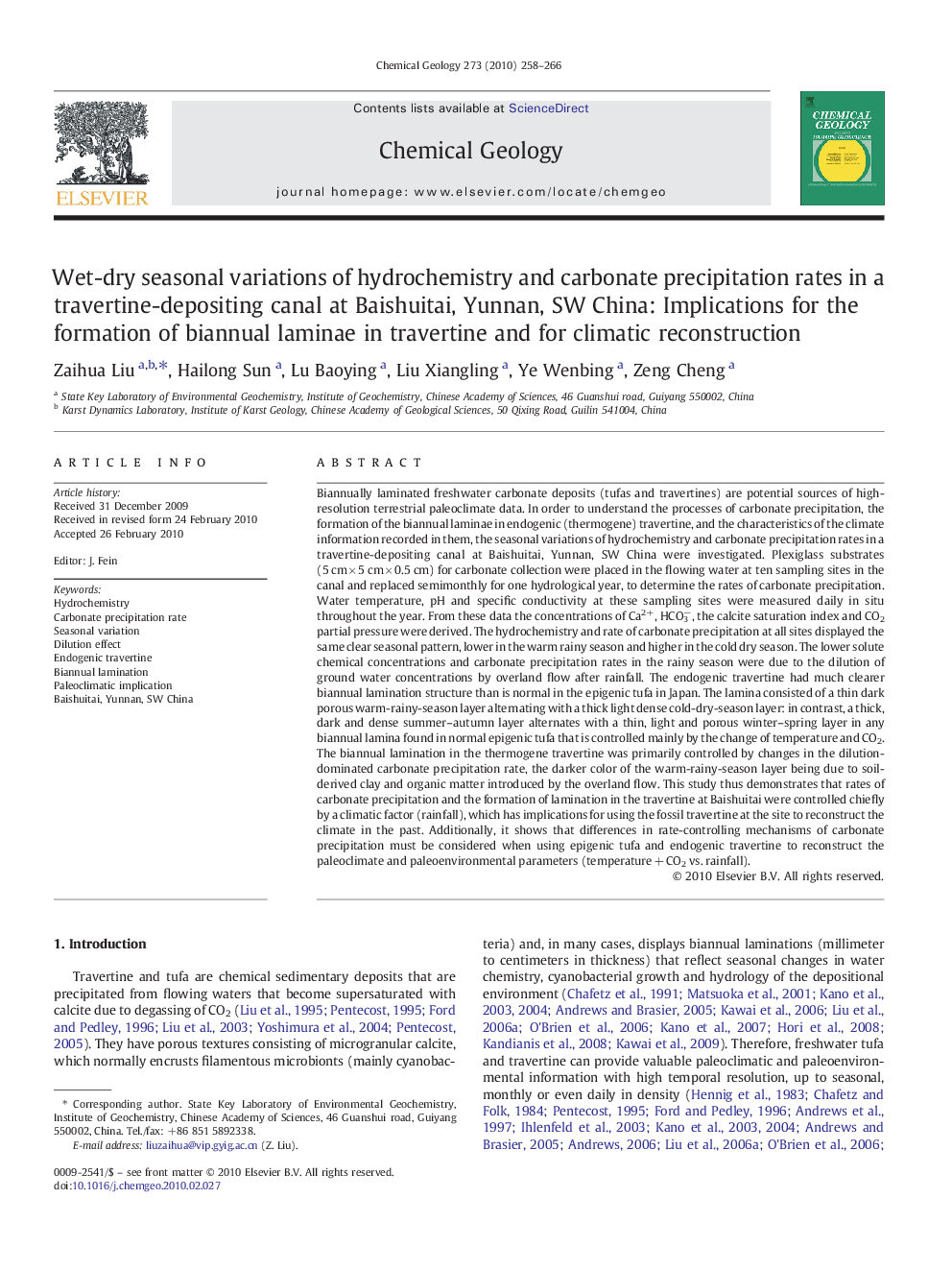| کد مقاله | کد نشریه | سال انتشار | مقاله انگلیسی | نسخه تمام متن |
|---|---|---|---|---|
| 4700042 | 1637689 | 2010 | 9 صفحه PDF | دانلود رایگان |
عنوان انگلیسی مقاله ISI
Wet-dry seasonal variations of hydrochemistry and carbonate precipitation rates in a travertine-depositing canal at Baishuitai, Yunnan, SW China: Implications for the formation of biannual laminae in travertine and for climatic reconstruction
دانلود مقاله + سفارش ترجمه
دانلود مقاله ISI انگلیسی
رایگان برای ایرانیان
موضوعات مرتبط
مهندسی و علوم پایه
علوم زمین و سیارات
ژئوشیمی و پترولوژی
پیش نمایش صفحه اول مقاله

چکیده انگلیسی
Biannually laminated freshwater carbonate deposits (tufas and travertines) are potential sources of high-resolution terrestrial paleoclimate data. In order to understand the processes of carbonate precipitation, the formation of the biannual laminae in endogenic (thermogene) travertine, and the characteristics of the climate information recorded in them, the seasonal variations of hydrochemistry and carbonate precipitation rates in a travertine-depositing canal at Baishuitai, Yunnan, SW China were investigated. Plexiglass substrates (5 cm Ã 5 cm Ã 0.5 cm) for carbonate collection were placed in the flowing water at ten sampling sites in the canal and replaced semimonthly for one hydrological year, to determine the rates of carbonate precipitation. Water temperature, pH and specific conductivity at these sampling sites were measured daily in situ throughout the year. From these data the concentrations of Ca2+, HCO3â, the calcite saturation index and CO2 partial pressure were derived. The hydrochemistry and rate of carbonate precipitation at all sites displayed the same clear seasonal pattern, lower in the warm rainy season and higher in the cold dry season. The lower solute chemical concentrations and carbonate precipitation rates in the rainy season were due to the dilution of ground water concentrations by overland flow after rainfall. The endogenic travertine had much clearer biannual lamination structure than is normal in the epigenic tufa in Japan. The lamina consisted of a thin dark porous warm-rainy-season layer alternating with a thick light dense cold-dry-season layer: in contrast, a thick, dark and dense summer-autumn layer alternates with a thin, light and porous winter-spring layer in any biannual lamina found in normal epigenic tufa that is controlled mainly by the change of temperature and CO2. The biannual lamination in the thermogene travertine was primarily controlled by changes in the dilution-dominated carbonate precipitation rate, the darker color of the warm-rainy-season layer being due to soil-derived clay and organic matter introduced by the overland flow. This study thus demonstrates that rates of carbonate precipitation and the formation of lamination in the travertine at Baishuitai were controlled chiefly by a climatic factor (rainfall), which has implications for using the fossil travertine at the site to reconstruct the climate in the past. Additionally, it shows that differences in rate-controlling mechanisms of carbonate precipitation must be considered when using epigenic tufa and endogenic travertine to reconstruct the paleoclimate and paleoenvironmental parameters (temperature + CO2 vs. rainfall).
ناشر
Database: Elsevier - ScienceDirect (ساینس دایرکت)
Journal: Chemical Geology - Volume 273, Issues 3â4, 15 May 2010, Pages 258-266
Journal: Chemical Geology - Volume 273, Issues 3â4, 15 May 2010, Pages 258-266
نویسندگان
Zaihua Liu, Hailong Sun, Lu Baoying, Liu Xiangling, Ye Wenbing, Zeng Cheng,